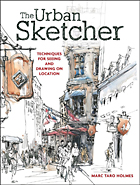Testing some new colors : Plus, finally getting a nice portrait
Trying out a new color: Daniel Smith Perylene Maroon.
I’ve learned this new term : Masstone. That is, the color when the pigment is applied full strength – as compared to when diluted. This pigment’s masstone is pretty damn nice if I might say. A deep purple/red that tints out into a fairly passable Northern European skin tone. This sketch is a good example I think.
This sketch is almost entirely done with the one color, Perylene Maroon. Using with a bit of DS Bloodstone Genuine for the darks in the hair, maybe the lightest hint of DS Quinacridone Deep Gold under the nose and along the left eye (an accidental touch really) and one stroke of DS Mayan Blue Genuine
at the back of the head.
This may be the perfect limited palette for figure painting dark haired Caucasians.
I’ve been idly looking for a solution for the poor light-fastness of my favorite cool-red Alizarin Crimson, which is well known to be unreliable when exposed to the light. Much like the Caucasians it is used to paint.
There’s a pretty straight-up hatchet job of poor pale Aliz over on Handprint.com. After reading that I had to do something about switching.
The only thing that is a bit daunting about this Maroon is its powerful tinting strength. The DS version I’m testing seems to easily overpowering other colors. It’s almost like there might be ‘beginner’ and ‘advanced’ palette choices. Alizarin is a pliable color. It’s compatible with a lot of things. I normally mix with Ultramarine blue to make darks, Burnt Sienna and Yellow Ocher to make flesh – both of which this new Maroon can simply do on its own. But I also use Alizarin in foliage quite often. Being a nice complement for green. So. I’ll have to keep testing and let you know how I like it in situations other than the life model.
DS Bloodstone Genuine on the other hand is challenging in the opposite way. It’s a velvety dark in masstone – a rich warm black. But weak as a kitten in dilution. I actually really like it – but it’s very hard to use. You almost need to use it impasto to get any power from it when edge-pulling with water. But it made a beautiful sedimentary haze next to her left eye socket – and in the hair mass behind her jaw.
Oh, and yes – this sketch was another incremental break-though for me. I’ve painted with Elissa many times – but it’s taken multiple tries, before I can finally recognize her. I really can’t emphasize enough how hard likenesses are. I don’t think it’s possible to get a great rendition on the first try. At least not by me. I keep gaining respect for the real portrait painters out there.



Very nice.
Thanks for sharing your experience with different colours. Nicely done!
Love the portrait! And I’m inspired by the maroon – I have a heck of a time getting skin tones right and this looks like fun. Thanks!
DS makes a Permanent Alizarin Crimson that has an excellent light fastness rating. Would that work?
Just noticed I didn’t reply here : short answer – probably! – Long answer: If I can just quote Burce MacEvoy the handprint.com guy: “If you want to make a one for one substitution, then there are five pigment substitutions for alizarin crimson currently offered in commercial watercolor paints: (1) benzimida carmine (PR176), (2) quinacridone pyrrolidone (PR N/A), (3) pyrrole rubine (PR264), (4) anthraquinone red (PR177, a chemical cousin of alizarin), and (5) a few relatively dark and reddish varieties of quinacridone violet (PV19). (These paints are typically offered under marketing names such as alizarin crimson hue, azo alizarin, quinacridone alizarin, permanent alizarin crimson, etc.) All these paints are semitransparent and don’t lose intensity or shift to brown when they dry, making them satisfactory color alternatives for alizarin crimson. However they all have marginal lightfastness (6,7 in my tests), which is still far better than the average lightfastness of alizarin crimson (1,5).
Reminds me somewhat of W&N Brown Madder… what do you think?
First off I love your painting of Elissa – the juicy washes, the variety of edges and the colors including the touches of Quin Gold. I have Perylene Maroon from DS but I’ve been a bit afraid of it so I’m going to get it out and play with it – get to know it better. It’s encouraging to me more than I can say to hear that it’s taken you a number of sessions to get her likeness – it gives me hope for myself and reinforces my stubborn determination to not give up! I love Handprint.com and have used it a lot myself. I see that the author hasn’t updated it in nearly 10 years and I’m wondering if paint manufacturers have changed their formulas such as with Alizarin Crimson to create something more light stable. What are your thoughts? Thanks so much.
Love the portrait. I just bought Perylene Maroon and am also fond of Peimontite by DS. I never thought to try it for skin — thanks!
BTW, your class is assisting me to get over being an architect with watercolors and be loose!
I love portrait paintings and I love your style. Thanks for the advice – I need to practice more!
Love, love, love the looseness of your painting style. I’m trying to get away from exacting precision. Very inspiring.
Hi Marc, do you know if Bloodstone Genuine works if I put it in a half pan, let it dry, and use it like a pan watercolor? Does it reactivate pretty well? Thanks!
Yes, that’s exactly how I use it. Squeeze the tubes into a pan and just refill as needed. I do carry a spray misting bottle (just a tiny one) and spritz the paints fairly often to get them to give up juicy color. ~m